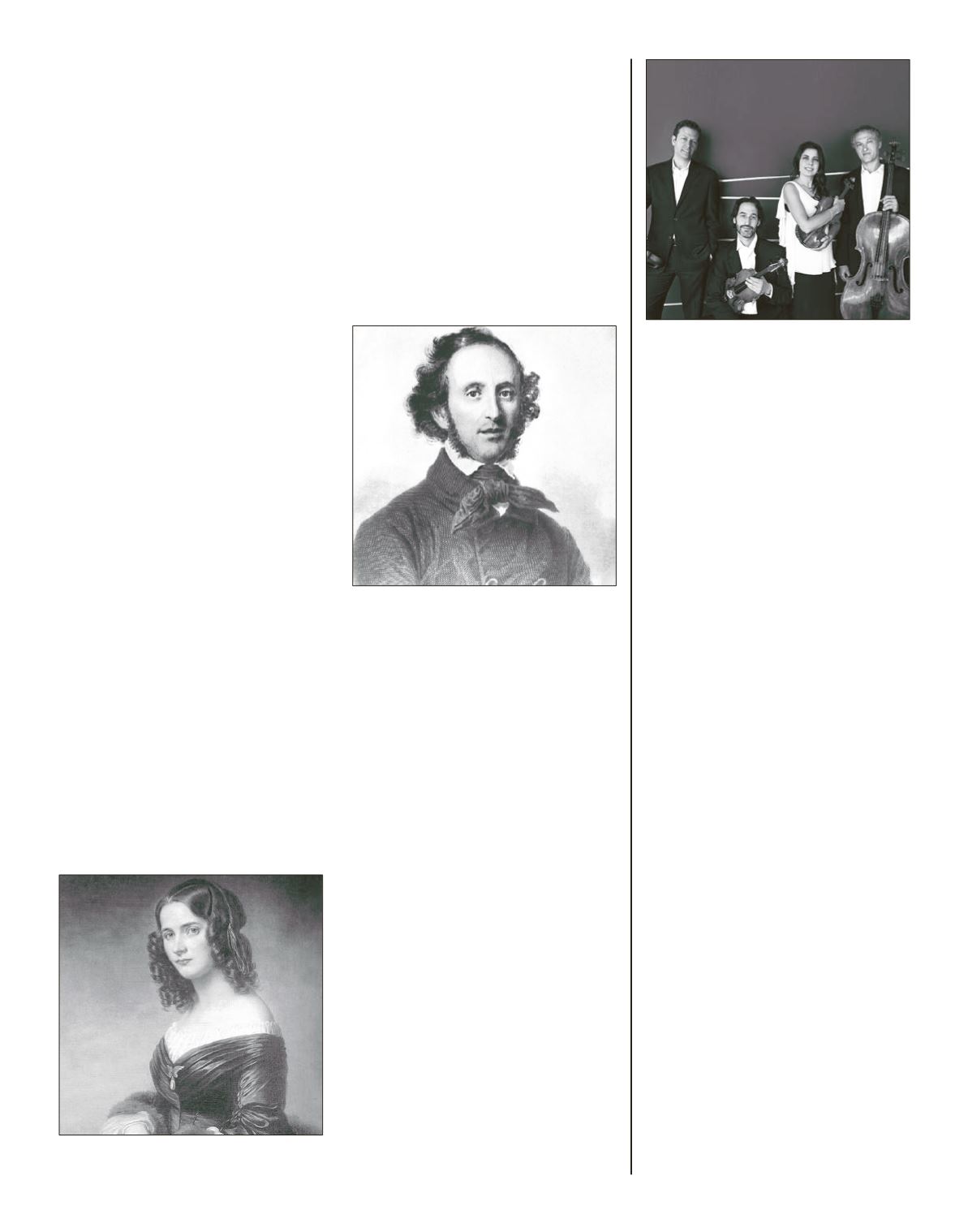
Bartók’s third movement presents a complete
contrast of character. e hushed upper strings
set a mystical background—typical of the com-
poser’s “night music”—for the chromatic cello
melody.
e rst violin continues with a bird-
call over the shimmering accompaniment of the
lower strings.
e second violin breaks the at-
mosphere with an
agitato
outburst. A
tranquillo
cello
theme restores the original mood; the rst
violin presents the theme inverted as a counter-
point to the cello. e movement closes quietly.
Bartók creates greater contrasts in the
Allegretto
pizzicato
, the
scherzo
counterpart to the second
movement, through a wide variety of e ects.
Multiple stops in all the instruments announce
the nale. Both violins introduce the aggressive
rst theme. A contrasting idea—prepared by
four measures of rest and muted second violin
and cello guration—begins in the rst violin
and viola. e cello recalls a quiet motive from
the rst movement, which, along with the na-
le’s rst theme, are developed and extended until
the end. e rst movement’s
pesante
concludes
the quartet.
FELIX MENDELSSOHN (1809–47)
String Quartet No. in D major, op. , no.
e newlyweds Felix Mendelssohn and Cécile
Jeanrenaud embarked on an extended honey-
moon and vacation immediately a er their nup-
tials on March ,
. e young conductor of
the Leipzig orchestra had met his future bride in
Frankfurt, where her father, now deceased, had
been pastor of the French Reformed Church.
By all accounts, Cécile was an attractive, qui-
et young woman eight years his junior who
seemed perfectly compatible with the famous
musician. “Her gure was slight, of middle
height and rather drooping, like a ower heavy
with dew, her luxuriant golden-brown hair fell
in rich curls on her shoulders, her complexion
was of transparent delicacy, her smile charm-
ing, and she had the most bewitching deep blue
eyes I ever beheld, with dark eyelashes and eye-
brows,” wrote Elise Polko.
Recollections of the two-month sojourn in
Swabia and the Upper Rhine survive in the
couple’s honeymoon diary. Melodic snatches
(even a complete
Allegretto
movement written
for Cécile), pressed owers, written fragments
of conversation, and pen-and-ink sketches ll
the pages with loving memories. Time quickly
passed amidst the constant activities of carriage
rides, long meals, and shopping.
e Mendels-
sohns followed their honeymoon proper with
three months of vacation. By the time they re-
turned to Leipzig in August, Cécile was two or
three months pregnant. Mendelssohn almost
immediately resumed his hectic conducting
schedule.
e industrious musician had not completely
avoided work during his honeymoon and va-
cation. In fact, Mendelssohn completed three
large-scale compositions during those ve
months: the Piano Concerto No. in D minor,
op.
; the choral-orchestral Psalm , op.
;
and the String Quartet No. in E minor.
is
last composition, completed on June , inaugu-
rated his magni cent series of three string quar-
tets published in
as op.
and dedicated to
the Crown Prince of Sweden.
Mendelssohn assumes a Classical posture in the
Quartet No. in D major, as demonstrated by
the
Molto allegro vivace
’s symmetrical phrasing,
the presence of an old-fashioned minuet move-
ment (the only minuet in his later string quar-
tets), and the work’s overall genial spirit.
e
Andante espressivo ma con moto
conveys a ten-
der lyrical quality, its melody o en paired with
a continually moving countermelody. Mendels-
sohn guides the
Presto con brio
nale through a
wide array of musical characters.
–Program notes ©
Todd E. Sullivan
PACIFICA QUARTET
e Paci ca Quartet formed in
and has
gained international stature as one of the nest
chamber ensembles over the past two decades.
e foursome quickly earned recognition in
chamber music’s top competitions, including
the
Naumburg Chamber Music Award.
In
the Paci ca Quartet was honored with
Chamber Music America’s Cleveland Quartet
Award and was invited to join Lincoln Cen-
ter’s CMS Two program, and then in
the
ensemble was awarded an Avery Fisher Career
Grant—only the second quartet to have received
the honor—and was featured on the cover of
Gramophone
magazine as one of “ ve new quar-
tets you should know about,” the only American
ensemble on the list. Finally, in
, the Paci-
ca Quartet was named Ensemble of the Year
by
Musical America
, the same year it earned a
Grammy Award for Best Chamber Music Per-
formance for Elliot Carter’s String Quartets Nos.
and and was appointed the quartet-in-resi-
dence at the Metropolitan Museum of Art un-
til
e quartet was also in residence at the
University of Illinois–Urbana-Champaign from
until
, when it became the resident
quartet at Indiana University’s Jacobs School of
Music, where each member is also on the faculty.
Longtime advocates of new music, the Paci ca
Quartet recently joined Johannes Moser in the
premiere of the cello quintet
Splendid Hopes
by
MacArthur Fellow Julia Wolfe. e Paci -
ca Quartet’s discography also includes Carter’s
other three quartets and the complete quartets
of Mendelssohn and Shostakovich—cycles the
quartet has also performed in concert around
the world—as well as quintets by Brahms with
pianist Menahem Pressler, by Leo Ornstein with
pianist Marc-André Hamelin, and by Mozart
and Brahms with clarinetist Anthony McGill.
e Paci ca Quartet rst appeared at Ravinia in
and returns for its third season at the festi-
val with two new members alongside co-found-
ers violinist Simin Ganatra and cellist Brandon
Vamos: violinist Austin Hartman and RSMI
alumnus violist Guy Ben-Ziony.
Cécile Jeanrenaud Mendelssohn
Felix Mendelssohn
AUGUST 20 – AUGUST 26, 2018 | RAVINIA MAGAZINE
121








